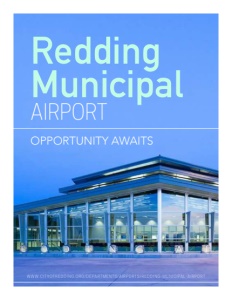Redding Municipal Airport
Opportunity awaits
Business View Magazine interviews Bryant W. Garrett, Manager of the Redding Municipal Airport, as part of our series on regional, U.S. airports.
Redding Municipal Airport is a general aviation and commercial airport located six miles southeast of the City of Redding in Shasta County, California. It is one of two airports operating under the jurisdiction of the city’s Department of Public Works Airports Division, the other being Benton Airpark, situated on 158 acres on Redding’s west side. Benton Park was the town’s first airport, purchased in 1920 for the purpose of developing an aerial landing space.
The Municipal Airport was originally the site of the Redding Army Air Field, acquired by the U.S. Army Corps of Engineers in 1942 for the Army Air Corps. Its mission was advanced fighter training of new airmen, prior to their deployment overseas into the combat zones of the Pacific, China, Mediterranean, or European Theaters. “The Airport came into existence right toward the end of the war,” explains Airports Manager, Bryant W. Garrett. “It came on line in December 1944, and it was fully staffed, and up and running, in the summer of ’45. After the bombing of Hiroshima and Nagasaki, the war came to a conclusion, quickly. And by 1949, it was handed off to the City of Redding.”
 According to Garrett, the Airport didn’t “take off” until the late ‘70s and early ‘80s, with mostly general aviation activities. Over the years, five commercial airlines provided passenger service at Redding, and four are now gone. Hughes Airwest flew Douglas DC-9-10s and McDonnell Douglas DC-9-30s to San Francisco, Los Angeles, Portland, and Seattle; Frontier’s Boeing 737-200s flew to Denver via Sacramento; Pacific Express BAC One-Elevens flew nonstop to San Francisco and on to Los Angeles, and also to Portland; American Eagle turboprops operating for American Airlines flew nonstop to San Jose, San Francisco, Eureka/Arcata, and Klamath Falls. United Airlines, which came to Redding in 1983, still flies non-stop and direct to San Francisco, with four flights a day on Bombardier CRJ 200s. This March, United will also begin adding service to Los Angeles.
According to Garrett, the Airport didn’t “take off” until the late ‘70s and early ‘80s, with mostly general aviation activities. Over the years, five commercial airlines provided passenger service at Redding, and four are now gone. Hughes Airwest flew Douglas DC-9-10s and McDonnell Douglas DC-9-30s to San Francisco, Los Angeles, Portland, and Seattle; Frontier’s Boeing 737-200s flew to Denver via Sacramento; Pacific Express BAC One-Elevens flew nonstop to San Francisco and on to Los Angeles, and also to Portland; American Eagle turboprops operating for American Airlines flew nonstop to San Jose, San Francisco, Eureka/Arcata, and Klamath Falls. United Airlines, which came to Redding in 1983, still flies non-stop and direct to San Francisco, with four flights a day on Bombardier CRJ 200s. This March, United will also begin adding service to Los Angeles.
Regarding Redding’s GA community, Garrett reports that between the Municipal Airport and Benton Air Park, “there are about 227 hangars – single-occupancy hangars such as T-hangars or Port-A-Ports – and most of them are full,” he reports. “There are 105 at Benton, with the balance at Redding. Right now, out of roughly 110-120 hangars here, I probably have 12 that are vacant.” Unlike most GA airports Redding does not have a waiting list, and Garrett believes that is due to some prolonged maintenance activity. “We had a $7.5 million pavement project in the vicinity of the T-hangars, and we replaced approximately 13 acres of very old pavement,” he says. “So, I believe that in the next 12 to 24 months, we’ll be completely full.”
Garrett has no immediate plans to build any new hangars because he doesn’t think they’d sell. “You’ve got to charge a rent that’s proportionate to the capital investment, and now it’s costing upwards of 900,000 to a million dollars for a bank of ten hangars,” he remarks. “I’m not sure the market is out there for people to be paying that. You would not build homes if you can’t fill them, and you would want to make is so that you’re charging a reasonable amount of money to recover the cost of your capital. So, the more they cost, the more we have to charge.”
Redding Municipal operates as an enterprise fund, which essentially means it’s supposed to be self-sufficient – without any support from the general fund. “That’s the basic rule,” says Garrett. “And if you added up my last ten years of profit and loss, we’re in the black, but not by much. I operate on about $2.2 million in sales and my expenses are roughly, $2.1 million.”

Redding Municipal has two asphalt runways: 16/34 runs north/south at 7,003 x 150’; and crosswind runway 12/30, at 5,067 x 150.’ And Garrett has notions about both of them. “I would like to see some major changes to the Airport’s geometry,” he states. “Three tenths of one percent of the time, I don’t have anything other than straight down on one end of the runway or the other. So, in essence, very, very seldom do I need a crosswinds runway. So, even though, on paper, we have two runways, we only have one at a time because they intersect. And so, the smaller runway does not get a ton of use and I would like to see it pulverized, so we can we lay out a parallel, general aviation runway to the east. Then, they could run simultaneous operations, and we could even entertain for an ILS (Instrument Landing System) and use it as a training runway.”
Garrett would also like to lengthen the main commercial runway. “As an air carrier runway, about the shortest runway you want to deal with is 7,000 feet; and we’re at 7,003,” he notes. “So, what I would like to do is use the U.S. Forest Service that has a place on the Airport, as part of my rationale to get a runway extension. We own a sufficient amount of land on the north end of the field to extend the runway maybe 1,600 feet and end up with about 8,600 feet, which would allow us to entertain among the largest of their fire-fighting aircraft – a DC-10. They could operate with full fuel and full retardant out of our field with 8,600 feet.
“So, that’s what I’m trying to sell, right now – that, along with the one I already brought up, which is the parallel runway. I believe if we go in that direction, with the concurrence of the FAA to move forward on either of those, that will set the stage for the fill-out of the rest of the raw land that’s at the Airport. Right now, we have a considerable amount of land, but until those changes are made, I think it’s going to be difficult to attract new business, because the easiest-to-develop land is on the east side of the Airport and that’s where all the changes would be. And so, it’s difficult to entice people to make investments over there, when there could be a runway put right through the middle of their project.”
In order to get those proposed changes made, Garrett says he would have to convince the FAA to increase the amount of the Airport’s funding. “Like every other airport, we are beholden to the FAA for our share of discretionary money,” he says. “Based on our size, we’re only getting slightly over the million dollars a year minimum. But I think if you look at where Redding is, strategically – we’re the furthest north on the I-5 corridor before you get into Oregon – I think that we can increase our prominence significantly with the right facilities. I think that debate will prevail with the FAA and I’m hoping that we would see some good discretionary funding from them.”
Meanwhile, Garrett says that some more immediate projects currently in the design stage should be implemented over the next 12-24 months. They include the reconstruction of a taxiway and the blast pad on the approach of runway 16/34. “Along with that, we’re due a surface rejuvenation on both runways,” he adds. “Even though I want to end up pulverizing runway 12/30, the intersecting shorter runway, until the FAA buys off on that, I have to maintain it to standards. The FAA requires a life of at least three years. So, if we chose to do the new runway, which would start off with an environmental assessment, it would be five years before we would be ready to construct it. So, I’m very comfortable with doing a surface treatment on both runways.”

“We’re going to replace all of the roadways in front of the terminal building; that’s going to be a big public pleaser,” he continues. “We did a $10 million terminal renovation in 2014; we’re now working on a lot of the pavement surfaces, but as you come into the Airport, the pavement is in dire need. I would guess it was originally put down in 1979 or 1980 and hasn’t had anything major done on it since that time. It’s lived its useful life and needs to be completely reconstructed. So, we’re looking at reconstructing all of the roadways and I’m hoping that we’re successful in trying to get the discretionary money. They came up with the additional billion dollars worth of discretionary money in a spending bill and this is the first year of it. The definition of what they consider to be a successful project is one that is not going to score high on the usual airport improvement program funding because it’s a lesser priority and roadway projects tend to fall in that category. We didn’t make the cut for the first round, but I’m waiting to hear on the second round and hope that that comes about. That’s about a $7 million project. It’s 100 funding, so we don’t have to have a local share.”
“We also had a magnetic variation change, so we’re no longer runway 16/34,” Garrett adds. “We need to change it to runway 17/35; change out all the signs, the vertical signs and the surface-painted signs, and all the publications, plus a lot of back and forth with the aviation community and the tower. So, it’s a lot of work. I’m also trying to get an instrument approach for my north, which every now and then, we fall back on using the back course off of the ILS. Two years ago, Skywest (which operates the United flights) told us they would no longer fly that. So, my air carrier on-time operations and cancellations are now kind of at risk if I don’t have this new approach, and they won’t give me the approach until the magnetic heading has been changed. So, it’s kind of like those little puzzles you used to do as a kid when you had those 16 squares and 15 little blocks and you had to put them in order. You’ve got to be strategically looking ahead as you put them in place and that’s what it’s taking to get all this done.”
Another one of those little blocks that Garrett is trying to nudge into place is how to increase air carrier operations to get more commercial travelers to use the Airport. And right now, the competition is winning. He explains: “You take a 50-mile radius around Redding, and since there are no other large airports within that 50-mile radius, you would assume, that all things being equal, that all the people who live in that area and fly, would fly out of your airport. That would be 100 percent of those people; but I only maintain 12 percent of that population. So, I have an 88 percent leakage to the competitor airport and that is Sacramento. Sacramento is, obviously, a medium hub and we’re a non-hub. But if the pricing is correct, the convenience factor should play in and I should be able to hold, certainly, more than 12 percent. So, the question is why is there such a disparity between those that are coming to the closest airport versus those that are going elsewhere? Well, you’ve got at least one low-cost carrier – Southwest – that dominates Sacramento. And then the other part of it is, it’s just a nice, easy, straight shot down I-5 from Redding to Sacramento. So, that’s what people are doing and I’m trying to convince them, the commercial flyers, that there’s a better option here at home.
“Like it or not, airline passengers equal profitability; it’s a simple equation. The only reason that we have a profit is simply because of the amount of air carrier activity we have. We had a lot more of that activity in our past – and not the distant past. Going back to 2005-06, we had non-stop service to Portland, with connecting service to Seattle, and we had non-stop to Los Angeles. So, I’m trying to reconstruct our past that I believe fell away only because of the national economy and the crash that occurred in 2008-09. For the Airport, it should be a low hurdle to get back to what we were just a little over a decade ago. I think the non-stop service to L.A. is the start of it and I think there’s a high opportunity for a non-stop heading east to Denver, and certainly to restore our service from the past to both Portland and Seattle.”
Garrett concludes that with more and more people moving from the San Francisco Bay area into the California heartland – to places like Redding – the city and the Airport are well-poised for future growth and development. “I think there’s just a lot of opportunity,” he avers. “We’re a Part-139 certified field; we have a thriving general aviation population and the larger corporate aircraft; we’ve got the Fire Attack Base; we have a feeder operation for Federal Express; we’ve got a vibrant training environment with Iasco Flight School and Air Shasta, a helicopter training base. Redding is just waiting for the capital investment that we can’t all handle ourself. So, we’re looking for strategic partners and I believe that once we get it started, it will be the beginning of much higher demand for the empty land that we have available. There’s just a lot of opportunity at Redding.”
Check out this handpicked feature on the Thomasville Regional Airport – A bit of Southern hospitality.
AT A GLANCE
WHO: Redding Municipal Airport
WHAT: A general aviation and commercial airport
WHERE: Six miles southeast of the City of Redding in Shasta County, California
WEBSITE: www.cityofredding.org/departments/airports/redding-municipal-airport




